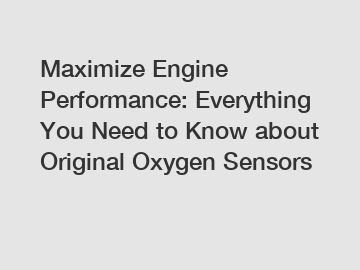Maximize Engine Performance: Everything You Need to Know about Original Oxygen Sensors
Maximize Engine Performance: Everything You Need to Know about Original Oxygen Sensors?
Are you looking to maximize your engine's performance? One crucial factor to consider is the role of original oxygen sensors. In this article, we will delve into everything you need to know about these sensors, exploring their function, importance, and tips for ensuring optimal engine performance.
1. Understanding the role of oxygen sensors:

Original oxygen sensors, also known as O2 sensors, play a vital role in monitoring the amount of oxygen in a vehicle's exhaust gases. They are typically located in the exhaust system and provide essential data to the engine control unit (ECU). This data helps the ECU adjust the air-fuel mixture, ensuring the right balance for efficient combustion.
2. Importance of original oxygen sensors:
(a) Precise fuel injection: Oxygen sensors enable the ECU to determine the precise amount of fuel needed for optimal combustion. This improves engine performance, fuel efficiency, and reduces harmful emissions. Using original oxygen sensors helps maintain the accuracy and reliability of these measurements.
(b) Longevity and reliability: Original oxygen sensors are designed specifically for your vehicle's make and model. They undergo rigorous testing and meet strict quality standards. Unlike aftermarket sensors, originals are built to last, ensuring reliable performance for an extended period.
(c) Compatibility with vehicle systems: Using original oxygen sensors ensures compatibility with other systems, such as the ECU and emissions control components. This compatibility is essential for seamless integration and optimal engine performance.
3. Signs of a failing oxygen sensor:
To maximize engine performance, it is crucial to identify signs of failing oxygen sensors. Some common symptoms include:
(a) Check Engine Light: A malfunctioning oxygen sensor can trigger the check engine light on your dashboard. It is advisable not to ignore this warning, as it could indicate potential engine issues.
(b) Decreased fuel efficiency: A faulty oxygen sensor may lead to an incorrect air-fuel mixture, resulting in decreased fuel efficiency. If you notice a sudden drop in your vehicle's mileage, it could be a sign of a failing sensor.
(c) Rough idling or engine misfires: Damaged oxygen sensors can disrupt the air-fuel mixture, leading to rough idling or even engine misfires. These symptoms can negatively impact engine performance and should be addressed promptly.
4. Maintaining and replacing oxygen sensors:
To maximize performance, it is essential to maintain and replace oxygen sensors when necessary.
(a) Regular maintenance: Follow your vehicle manufacturer's recommended maintenance schedule. Regular check-ups and inspections can help identify issues with oxygen sensors, enabling timely repairs or replacements.
(b) Replacement intervals: Oxygen sensors have a limited lifespan, typically around 50,000 to 60,000 miles. However, this can vary depending on driving conditions and the sensor's quality. Consulting your vehicle manual or a trusted mechanic will provide guidance on when to replace them.
(c) Choosing original sensors: When replacing oxygen sensors, opt for original equipment manufacturer (OEM) parts. These sensors are specifically designed for your vehicle's make and model, ensuring the best compatibility and performance.
5. Tips for optimal engine performance:
Now that you understand the significance of original oxygen sensors let's explore some additional tips to maximize your engine's performance.
(a) Keep up with regular maintenance: Follow the recommended maintenance schedule, including oil changes, air filter replacements, and tune-ups. These tasks contribute to overall engine health and efficiency.
(b) Use high-quality fuel: Fill up with high-quality fuel from reputable sources. Poor quality or contaminated fuel can negatively impact engine performance, potentially affecting oxygen sensor operation as well.
(c) Drive sensibly: Opt for smooth and consistent driving habits, avoiding excessive acceleration or sudden braking. This helps maintain a stable air-fuel mixture and prevents unnecessary strain on the engine.
(d) Monitor tire pressure: Properly inflated tires reduce rolling resistance, improving fuel efficiency and reducing strain on the engine.
In conclusion, original oxygen sensors play a crucial role in maximizing engine performance. Their ability to measure oxygen levels in exhaust gases allows the engine control unit to adjust the air-fuel mixture precisely. By understanding the importance of these sensors, recognizing signs of failure, and following maintenance practices, you can ensure your engine operates at its peak performance, ultimately enhancing fuel efficiency and reducing emissions. So, don't overlook the significance of original oxygen sensors in your quest to maximize engine performance!
For more Buy Cylinder Head for MG GS, signs of exhaust manifold leak, mg auto ltdinformation, please contact us. We will provide professional answers.

Comments